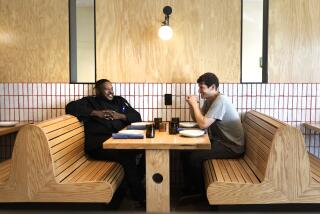Column: These chefs-in-training have overcome a lot. Now, they’d like a job
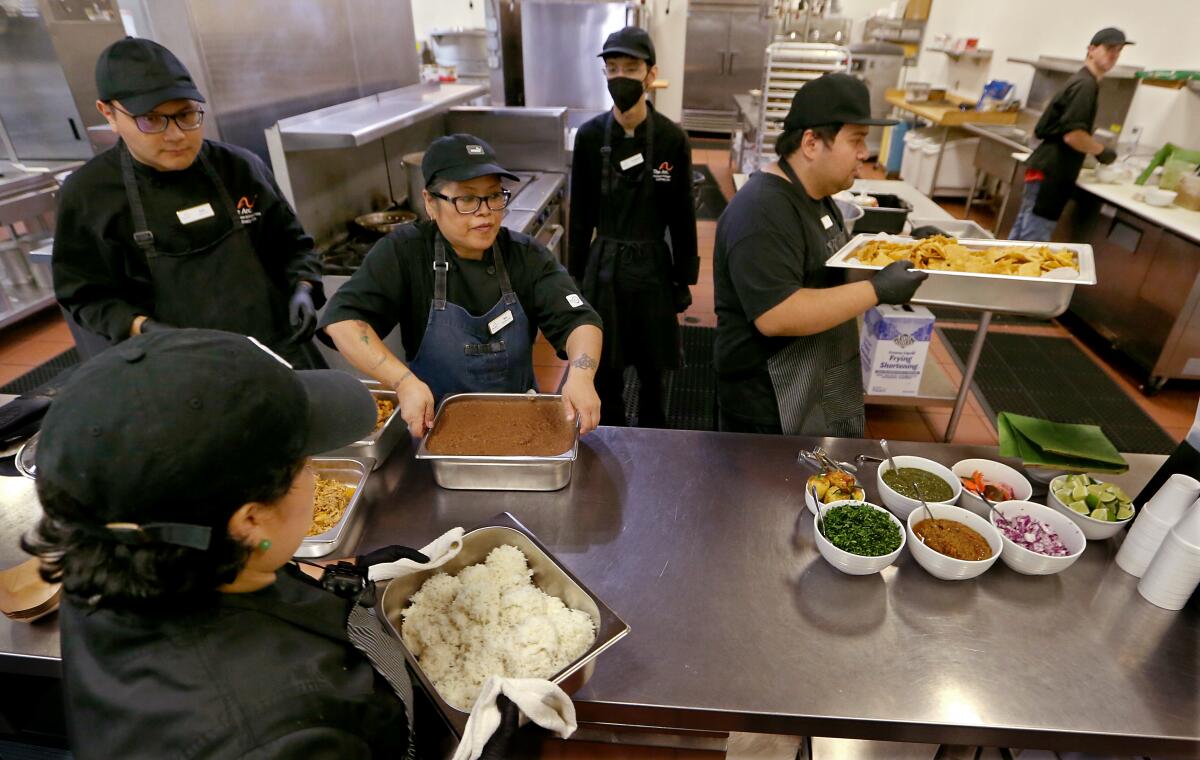
Shin rolled out the cookie dough. Asia sauteed the onions. Christopher fried the tortilla chips. Richard cooked the pinto beans.
The kitchen at the Arc Los Angeles and Orange Counties in Downey was hopping.
For the past two weeks, the nonprofit’s culinary students — seven men ranging in age from 22 to 41, decked out in black chef’s coats with metal tags that included their first names and “Future Chef” — had catered breakfast and lunch for a human resources conference. This was the final day, and lunch would be a feast for 50 of chicken tinga, cochinita pibil and bean-and-potato tacos.
The students are all on the autism spectrum. Christopher largely kept to himself. Richard monitored the pinto beans with a timer he assiduously reset every time it went off. Sean mashed the guacamole while an Arc staffer held the bowl. Kristian, the most talkative of the group, needed gentle prodding from the Arc executive chef Bev Lazo-Gonzalez to focus on his job.
Otherwise, they were like any other line chefs in any restaurant kitchen — except they weren’t allowed to handle knives.
“I love being able to show their families that they’re capable of handling big projects like what we’re now doing,” said sous chef Virginia Reynosa, 37, who has worked with the Arc since 2013. “They’re surprised at what their [autistic family members] can do.”

“I’m tough on them because, I tell them, ‘I want you to be ready,’ and they take it,” said Lazo-Gonzalez, 53. Her son Josef is on the autism spectrum and was helping her on this day. Usually, he attends classes at Cerritos College, where he’s majoring in music.
Gas stoves roared. Pots clanged. Industrial-sized mixers purred. People yelled out restaurant lingo — “Behind!” “Corner!” “Coming through, hot!” — as Maroon 5 and Selena played loudly from a Pandora station.
Lazo-Gonzalez roamed around to check on everyone’s progress. Sometimes, she jumped in to demonstrate techniques: Use regular salt instead of kosher salt on the cookie dough. Knead the pork for the cochinita pibil so it soaks up the citrus marinade better. To cook rice the best way — the Filipino way, according to her — fill a rice cooker with water just below the second knuckle of your middle finger.
Mostly, she offered words of encouragement peppered with “hon” and “love.”
“All week, you were prepping for this,” she told her crew before they took a short break. And she had some news: The conference wanted to add to its order.
“It’s kind of late, but we’ll make it work,” she said. Then she smiled. “Who needs coffee like I do?”
Everyone raised their hands and cheered.
Since 1956, the Arc has provided services for adults with intellectual and developmental disabilities, including art classes, field trips and job training, from a small complex of buildings in the industrial part of Downey. Six years ago, the nonprofit began a free culinary arts program that prepares clients to work in the restaurant industry as cooks and dishwashers.
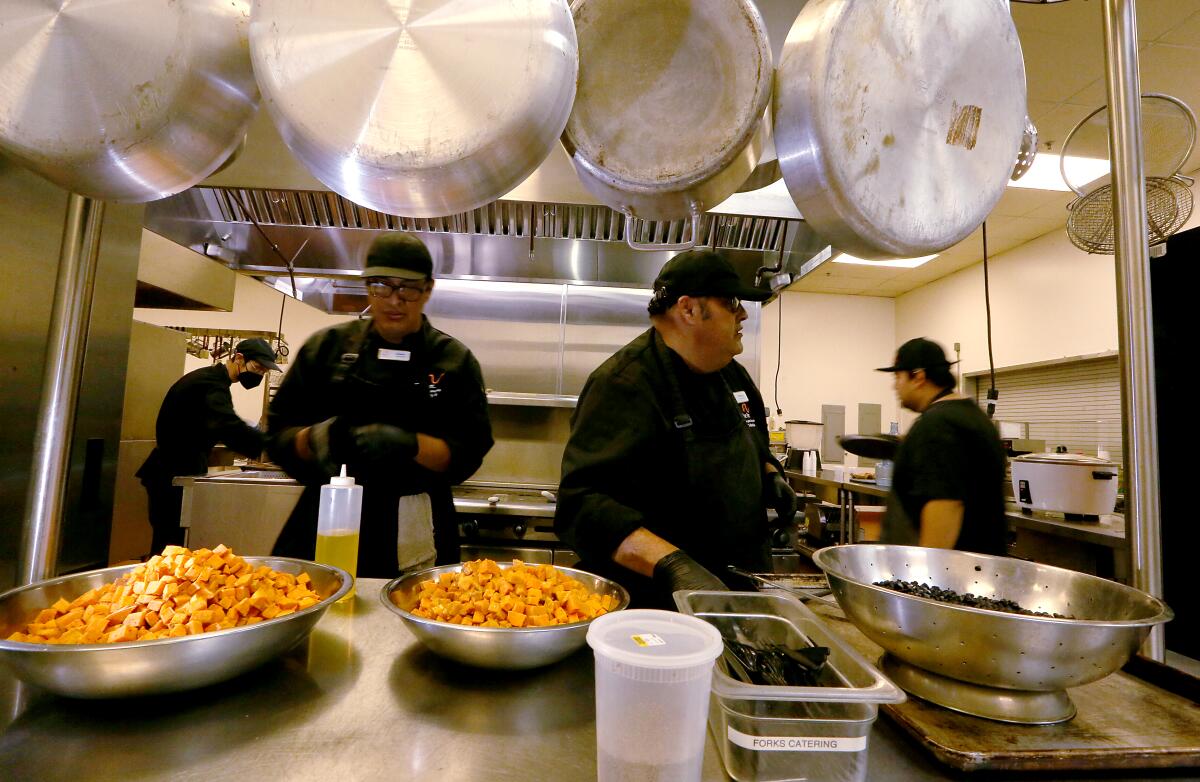
This summer, the Arc launched an ambitious project to provide real world experience, refurbishing a banquet hall so it could be rented, with catering provided by the students. The two-week conference was their first big test.
A previous administration had upgraded the Arc’s kitchen to an industrial-sized spot, but CEO Emilio Sosa — who’s also president of the Los Nietos School District Board of Trustees — felt that participants weren’t getting the most out of it.
“The banquet hall look like it was from the 1980s,” Sosa said in an interview from his office. “They were making only sandwiches and salads for our other participants. If our goal is to provide them real-life experience, then we needed to turn the kitchen into a place to do that.”
Sosa’s idea was also born out of necessity. In the fall of 2021, Gov. Gavin Newsom signed a bill that prohibited paying workers with disabilities less than the minimum wage, which had been allowed under a 1938 federal statute meant to make hiring them easier. Advocates for the bill argued that allowed workers with disabilities to be exploited.
Many of the Arc’s clients who held jobs lost them soon afterward, as businesses balked at paying minimum wage. Because of the increased labor costs, the Arc’s on-site packing warehouse, which employed former clients, had to close. It then relaunched as a thrift store with a vastly reduced staff before shuttering because of lack of sales.
“Employers don’t want to take the jump for our participants — catering is a way to show them off,” said Sosa.
“They keep telling me they miss working,” Lazo-Gonzalez said. Under her, everyone trains seven hours a day, five days a week, with a mix of hands-on workshops and lectures. They still cook lunch every day for other Arc participants but have upped their game with weekly specials based on Lazo-Gonzalez’s recipes or their own suggestions. They can also do off-site catering.
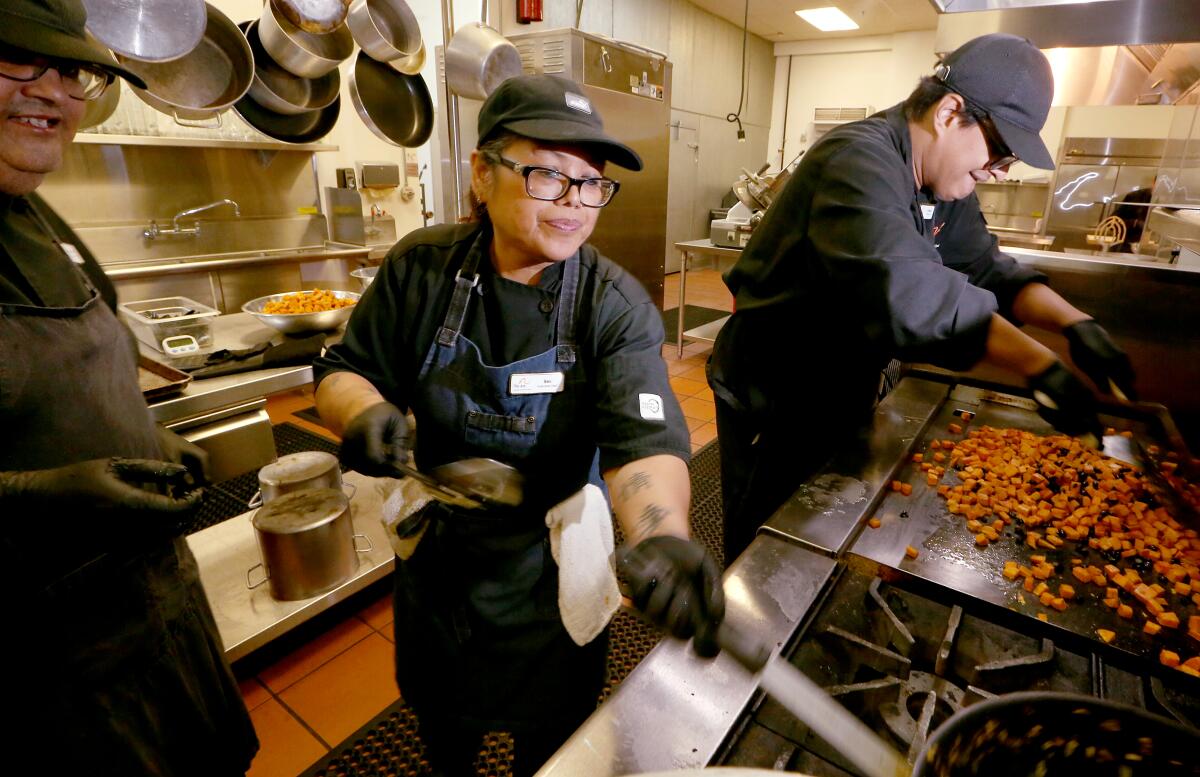
“If I ever did open a restaurant, they would be my first hire,” said Lazo-Gonzalez, a veteran of upscale restaurant chains like Border Grill and Slapfish. “A lot of people in restaurants start off thinking they’re a rock star. Here, everyone is grateful just for the chance.”
She tries to arrange field trips but gets few responses from restaurants and grocery stores.
“I know they’re busy,” Lazo-Gonzalez said with a disappointed look on her face, “but we want the guys to see what’s out there.”
Right before lunchtime, I asked some of the Arc’s aspiring chefs how they felt.
“It helps me improve my future and fulfill my dreams,” said Asia, who started a couple of months ago. (The Arc doesn’t disclose the last names of clients, citing privacy concerns.)
“I’m learning a lot,” Christopher said.
Richard had worked for a while at a warehouse but didn’t like it “because they weren’t nice.” He and Sean were moonlighting for the day, and while he doesn’t want to work in the restaurant industry, “I like to work and want to work.”
“It’s fun, what we do,” Kristian said. He’s about to transition out of the program after four years to enter the Arc’s career development track and hopes to be the first of his peers to land a job in the culinary world. “I’m getting skills and friends.
“OK,” he then cracked, “let me get my groove back on!”
By the time the conference was ready for lunch, the energy in the kitchen had ratcheted up. A couple of the guys went out to serve at the buffet line, while the others cleaned up what was left — not much, since everyone wiped down their work stations before moving to another task.
Near the center of the banquet hall, conference organizers raved about their experience.
“The quality of the food and the professionalism was amazing,” said Elsa Leal of Monrovia. “I think I want to hold my daughter’s quinceañera here.”
“It’s a great way for them to showcase what they do,” added Whittier resident Laura Ramirez.
“A lot of times, you go to somewhere for a conference, and they don’t have everything,” said Yvette Martin. “Here, it’s all pros.”
As the conference attendees ate, the Arc team retired to a private room so Lazo-Gonzalez and Reynosa could serve them lunch. Someone had written “Good Luck” on a whiteboard. I joined them for a delicious meal with a bonus: grilled chile güeritos.
The next day, they would enjoy a day off with pizza and karaoke. Soon after, they would begin to plan a Harry Potter-themed dinner for October that will be their first try at serving the general public, something Lazo-Gonzalez wants to do once a month. Right now, they gossiped as in any other break room.
Kristian asked Josef about a Blink 182 concert he had attended. That turned the talk to their favorite bassists. Asia showed me YouTube videos. Richard, Sean and Christopher silently ate, until someone began thinking out loud about what Lazo-Gonzalez should teach them to make next.
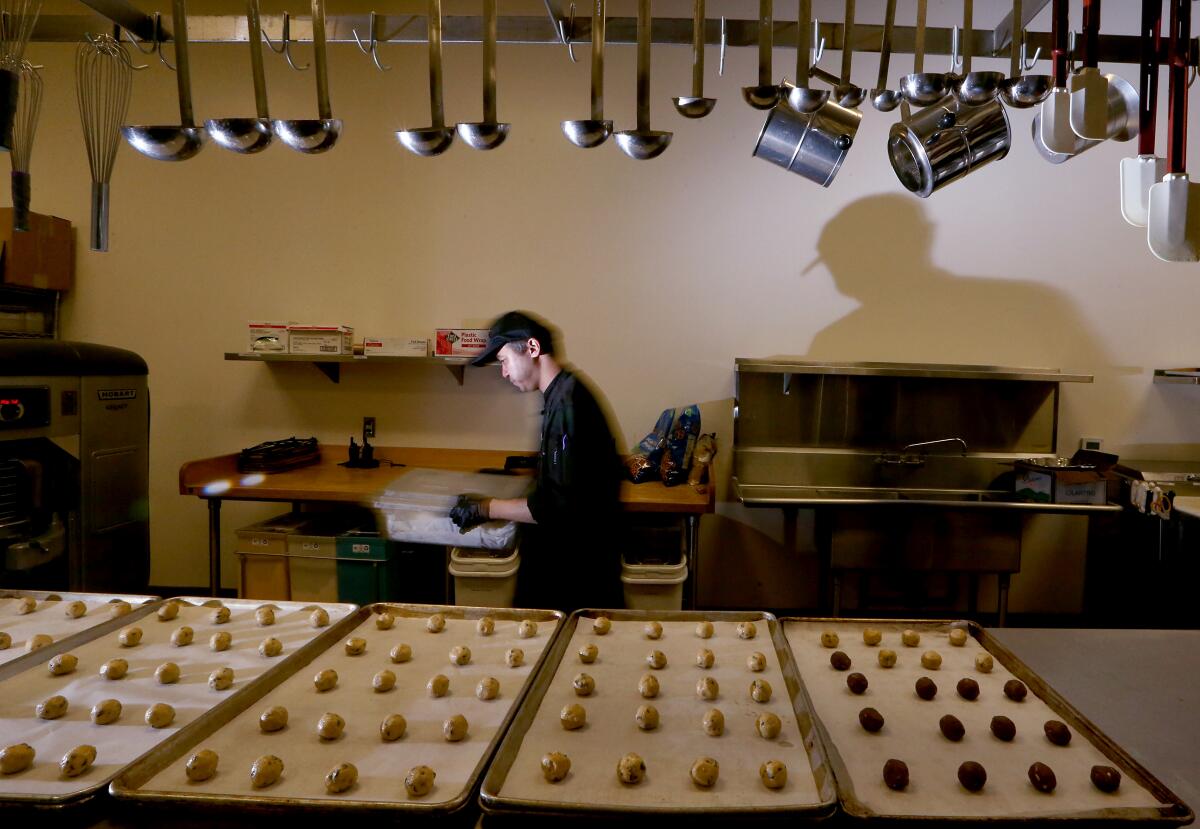
Ricardo, who had largely been silent that morning, suggested enchiladas. Shin countered with kimchi rice.
“Pasta carbonara,” Asia responded.
“A whole lechón!” Kristian blurted out, which drew an impressed laugh from Lazo-Gonzalez.
“You all have to be here at five in the morning for that! You all ready?”
They are.
More to Read
Sign up for Essential California
The most important California stories and recommendations in your inbox every morning.
You may occasionally receive promotional content from the Los Angeles Times.
